Heritage Alive: Ha Giang Traditional Festivals
Ha Giang, the leading land of the country, boasts not only a wealth of attractive tourist attractions but also a vibrant cultural landscape, with the presence of more than 20 ethnic minorities. As you embark on your Ha Giang motorbike tour, be sure to immerse yourself in the rich cultural tapestry of the region by experiencing these captivating Ha Giang traditional festivals. The article below from Vietnam Motorbike Tour Expert will offer motorbike enthusiasts a comprehensive and unique insight into the diverse tapestry of this remarkable land.
Overview of Ha Giang Traditional Festivals
The vibrant tapestry of ethnic minority cultures in Vietnam’s northern highlands comes alive through the captivating Ha Giang traditional festivals. Events like the lively Khau Vai Love Market, where the Dao and Giay people gather for courtship rituals, and the vibrant Buckwheat Flower Festival celebrating the blooming season offer an authentic glimpse into the region’s rich heritage.
The Ha Giang motorbike tour allows visitors to immerse themselves in the festive atmosphere, witnessing colorful displays of traditional dress, music, and dance that have been preserved for generations. With knowledgeable local guides – such as Vietnam Motorbike Tour Expert leading the way, travelers navigate the winding mountain roads, arriving at remote villages to partake in these unique celebrations alongside warm and welcoming ethnic communities. Let’s explore the top nine traditional festivals of Ha Giang in the following section.
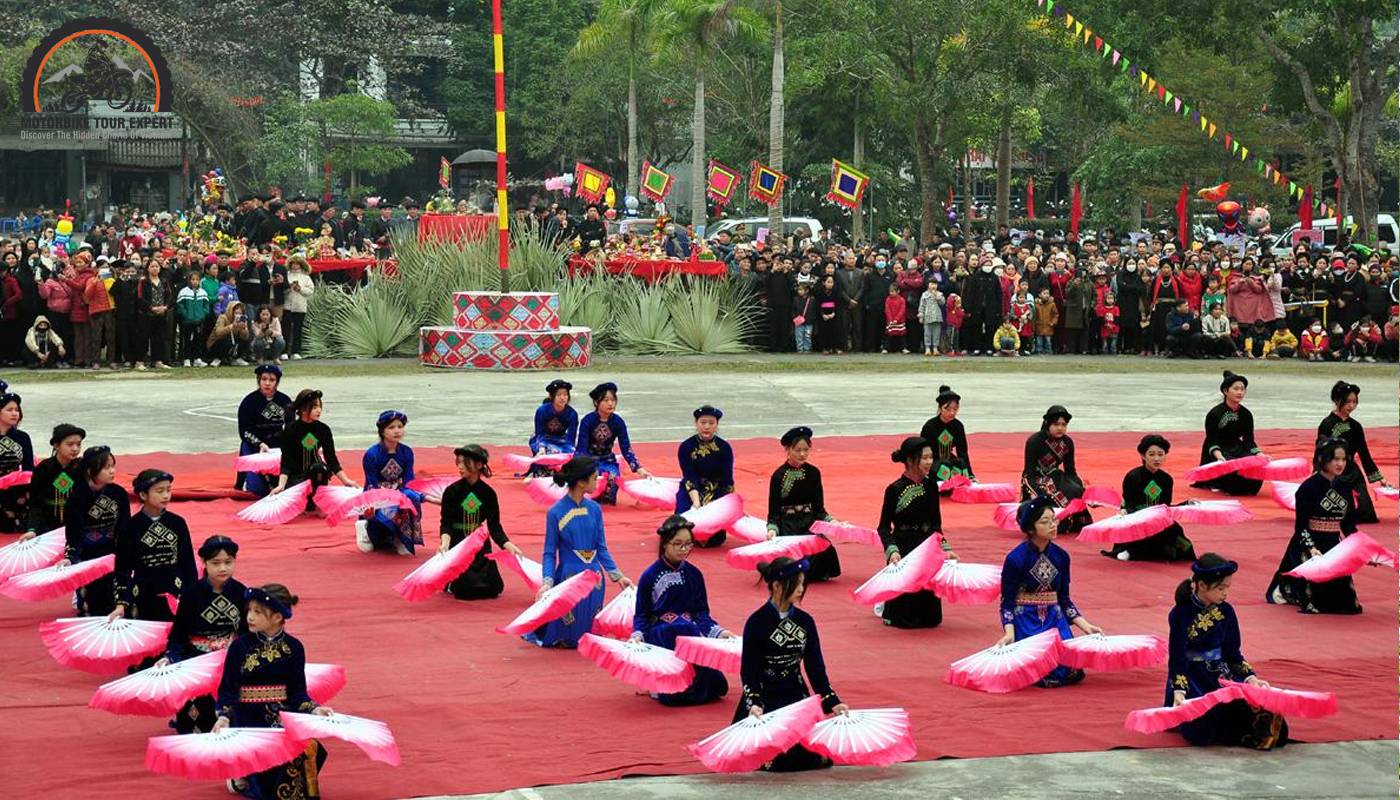
The broader view of traditional festivals in Ha Giang
Top unique festivals in Ha Giang
Gau Tao Festival
Among the numerous traditional festivals in Ha Giang, the Gau Tao Festival emerges as the most prominent and grandiose celebration of the H’Mong ethnic group, occurring annually from January 1st to 15th. This festival is a cornerstone of Northern Vietnam motorcycle tours, offering participants the opportunity to immerse themselves in cultural richness. The event is fundamentally aimed at invoking good fortune and prosperity, featuring rituals that bestow blessings on families and protect against misfortune.
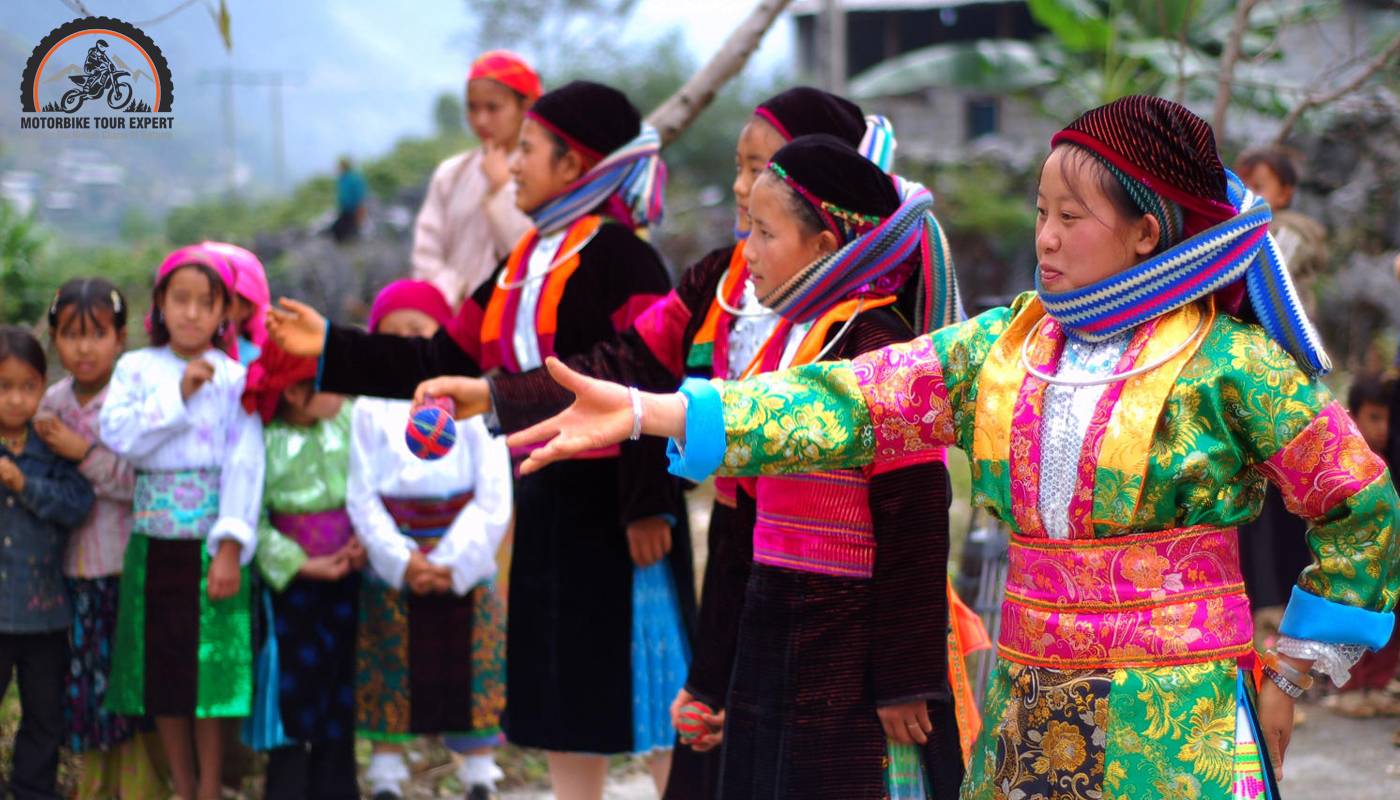
Top unique festivals in Ha Giang are a unique highlight in your journey of discovery
The festival features two distinct ceremonies:
- Praying for Blessings: Families who lack children or have few children will ask a relative with both a son and a daughter to cut down a tall apricot tree and erect it, in the hope of receiving divine blessings.
- Praying for Destiny: Households with a sick, weak, or deceased family member will appoint two young men to cut apricot blossoms and set up a tree, seeking to overcome their challenges.
Throughout the festival, an array of captivating activities and games take place, including spinning, archery, horse jumping, flute dancing, and the unique spectacle of bird’s nest fighting..
Fire Jumping Festival
As you embark on your Ha Giang motorbike tour, immerse yourself in the captivating celebration of the Pa Then ethnic group’s “Fire Jumping Festival”, also known as the Fireball Festival. Held annually on the 16th day of the 10th lunar month, this Ha Giang Traditional festival is a testament to the Pa Then people’s deep spiritual connection with the natural world.
The festival takes place at the time when the crops have been harvested, marking the harshest point of winter. According to the Pa Then beliefs, fire is the highest god, symbolizing peace and luck. The purpose of the fire dancing festival is to pray for a bountiful harvest, and good health, and to ward off all bad luck.
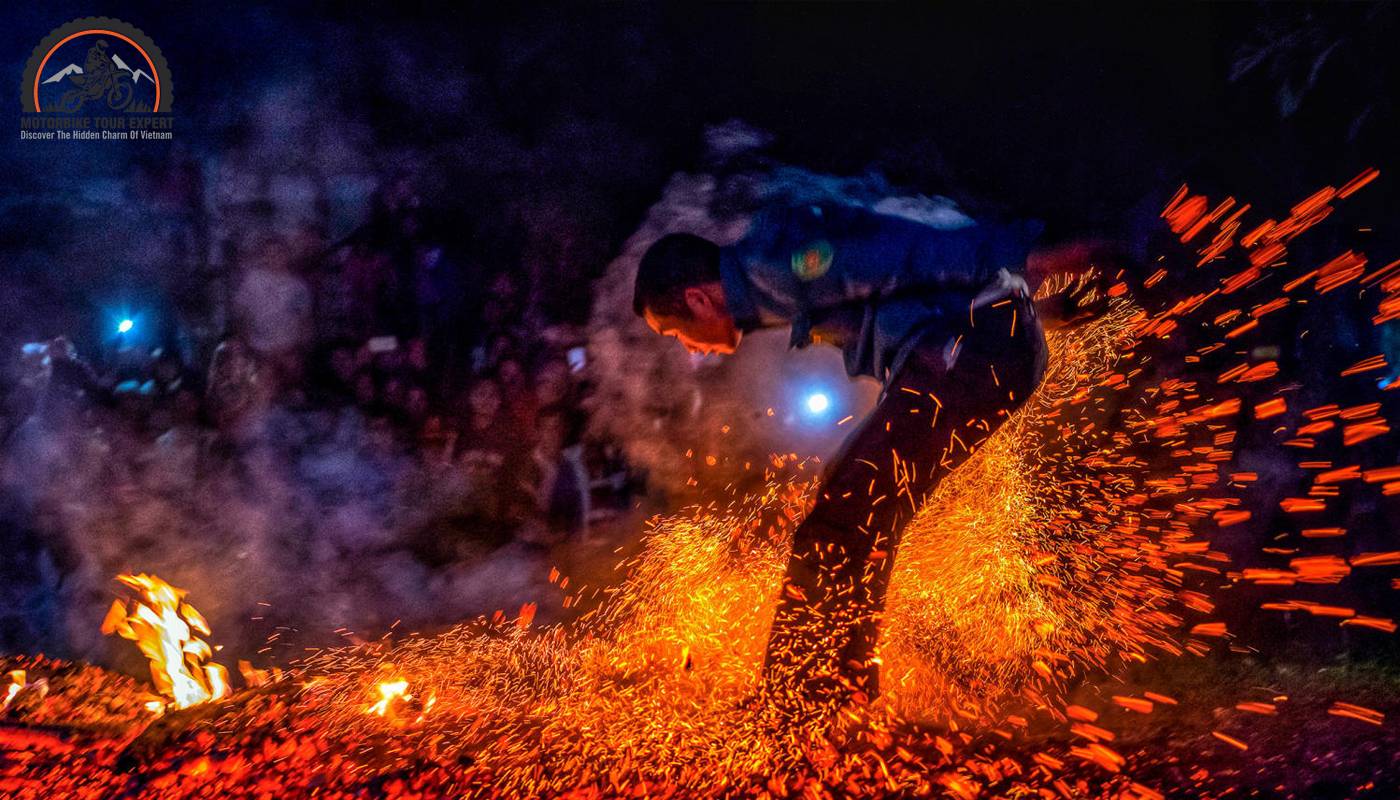
The young men in the village will begin to ask for the power of the gods to “enter the medium” and jump into the burning fire
This unique Ha Giang traditional festival begins with each family making offerings to the gods. The ritualistic offerings typically include a rooster, a bowl of rice, wine, paper money, and incense. After these offerings are made, and the gods are called upon for about 5-7 hours, the festival reaches its climactic moment around 8 p.m.
The young men of the Pa Then community, seated opposite the shaman, then demonstrate their unwavering spirit and resilience by jumping through blazing fires for 3-4 minutes. Remarkably, these true artisans emerge from the flames unscathed, showcasing the deep spiritual connection between the Pa Then people and the elemental power of fire.
Buckwheat Flower Festival
Typically held in the second half of November, the Buckwheat Flower Festival takes place in various venues throughout the region, such as the Dong Van town stadium or the Khau Vai Love Market. The festival provides visitors with an unparalleled opportunity to marvel at the breathtaking sight of the vast buckwheat flower fields that adorn the landscape.
Beyond the stunning floral displays, the Buckwheat Flower Ha Giang traditional Festivals offer a diverse array of engaging activities and experiences. Visitors can participate in tournaments and contests, including a buckwheat flower cake-making competition and a thrilling boat race to conquer the picturesque Tu San alley.
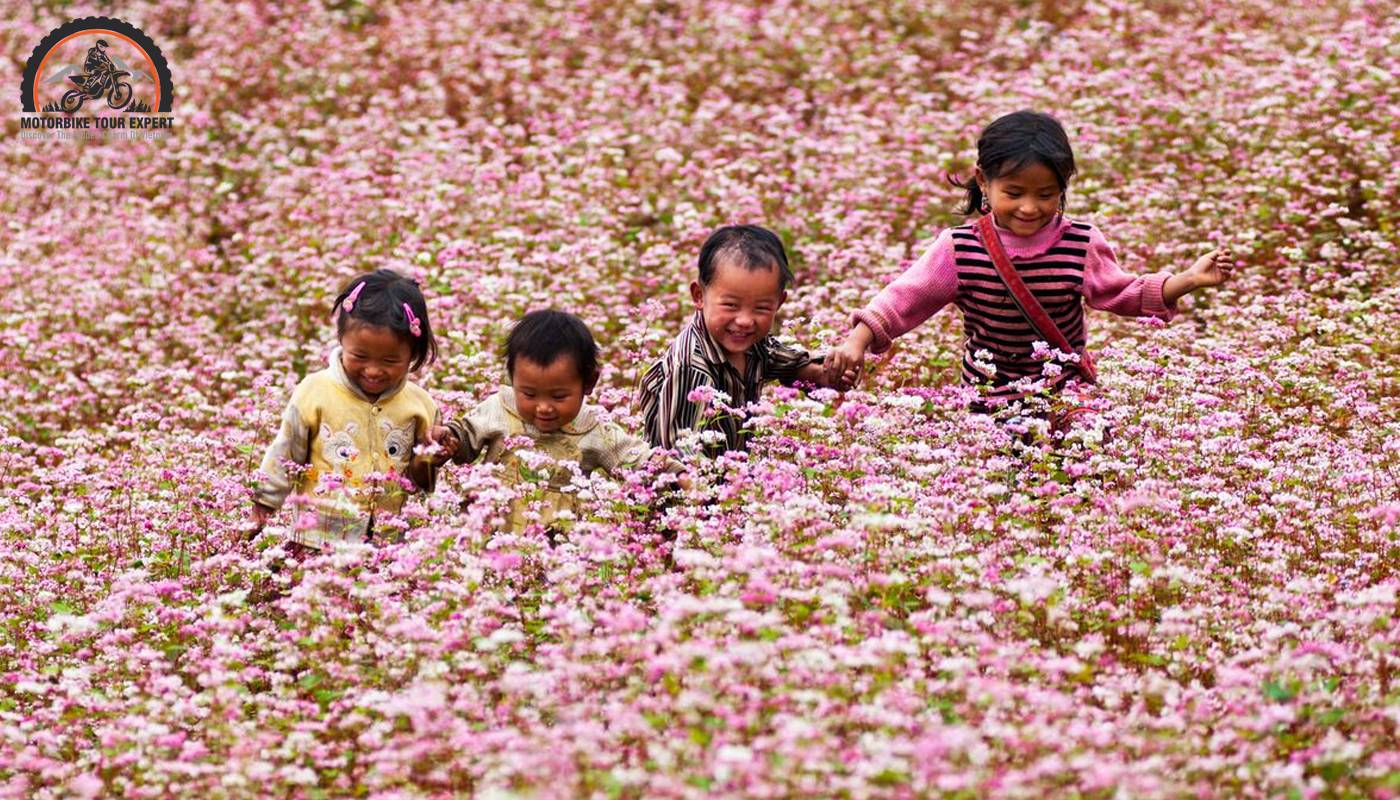
Visitors will have the opportunity to get closer to the cultural identity and life of the villagers here through the festival
The photographic opportunities during the Buckwheat Flower Festival are truly remarkable, with the blooming flowers distributed across various districts in Ha Giang, such as Dong Van, Quan Ba, Yen Minh, and Meo Vac. Visitors can capture the essence of this captivating celebration and the region’s natural beauty through their lenses.
Moon Bridge Festival
The Moon Bridge Festival is held annually on the 15th day of the 8th lunar month, coinciding with the Mid-Autumn Festival. For the Tay people of Ban Loan village in Yen Dinh commune, Bac Me district, the Mother Moon is a revered deity who blesses the earth. This festival is organized as a celebration to welcome the Mother Moon and fairies, with prayers for peace, luck, and a bountiful harvest.
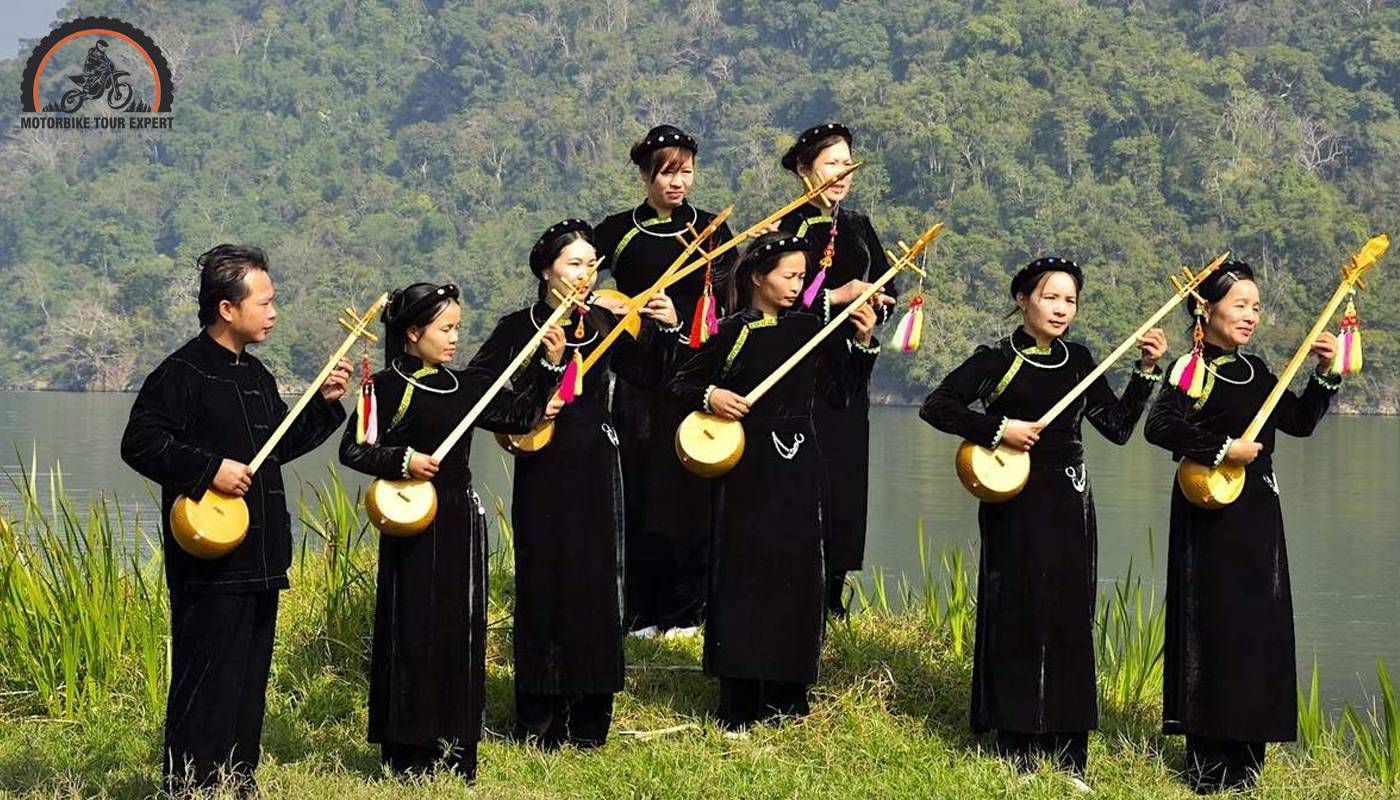
The Tay People’s Moon Festival is usually held on the 15th day of the 8th lunar month
The festivities begin on the 14th day, with the main ceremony taking place on the full moon day. During one of these interesting Ha Giang traditional festivals, visitors to Ha Giang can immerse themselves in the traditional Tay ethnic cuisine, captivating folk songs, and a variety of fascinating folk games. Experiencing the Moon Bridge Festival during your Ha Giang motorbike tour will offer you a unique opportunity to connect with the Tay ethnic community and gain a deeper understanding of the cultural traditions that define the essence of this captivating region.
Long Tong Festival – Ha Giang Spring Festival
As you plan your Ha Giang motorbike tour, be sure to immerse yourself in the captivating celebration of the Long Tong Festival – the vibrant Ha Giang traditional festival that showcases the rich cultural heritage of the region.
The Long Tong Festival, often referred to as the “festival of going down to the field” is a celebration primarily observed by the Tay ethnic group, though it also gathers the most typical cultural nuances of other ethnic groups such as the Nung and Dao people. This Ha Giang traditional festival typically takes place in the first few days of the lunar new year, lasting until the beginning of the second month.
The essence of the Long Tong Festival lies in its religious significance, as it serves as a time to pray to the divine for favorable weather, lush vegetation, bountiful harvests, and a prosperous life. The festival is held in a large open area or a flat field, where a towering apricot tree, standing 20 – 25 meters tall, is erected in the center. The top of the tree features a bull’s-eye with two high and low circles, symbolizing the yin-yang, the root of the universe and the progenitor of all things.
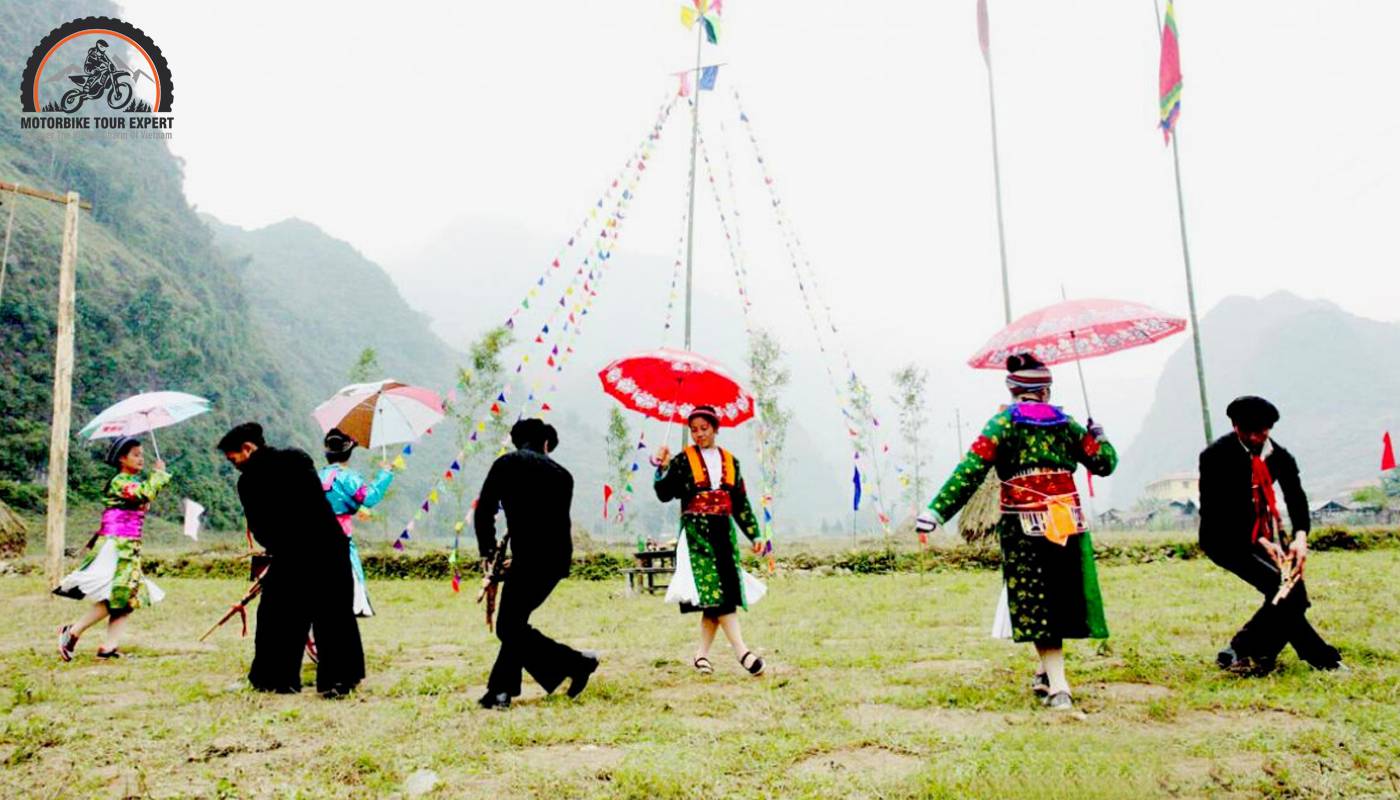
Join the Ha Giang motorbike tour to feel the uniqueness of this festival
Spring Festival of the Lo Lo Ethnic
The Lo Lo people predominantly reside in the Dong Van and Meo Vac districts of Ha Giang province. Despite the ongoing modernization of their lives, the Lo Lo have steadfastly preserved their unique cultural heritage, which is celebrated through the vibrant Spring Festival.
The centerpiece of this festival is the Rain Praying Festival, which is held in years when the weather is particularly harsh. The festival takes place on the 15th, 17th, and 19th days of the third lunar month, during which the Lo Lo people come together to pray for the gods to bless the heavens and the earth with favorable weather, abundant rainfall, and bountiful harvest. The ultimate goal of this Ha Giang traditional festivals is to ensure the prosperity and well-being of the entire village community.
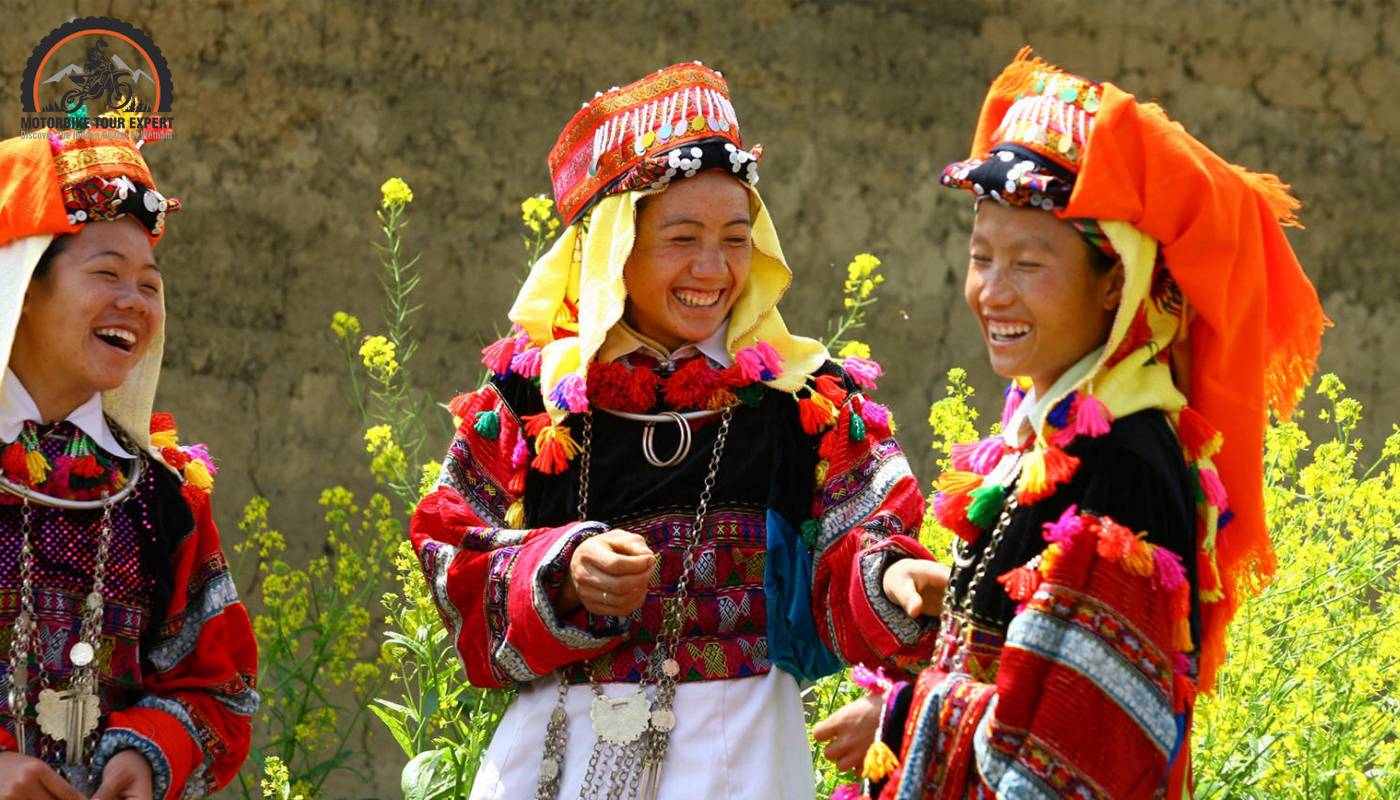
Experiencing the Spring Festival of the Lo Lo ethnic group during your Ha Giang motorbike tour
Khau Vai Love Market Festival in Ha Giang
When enjoying your Ha Giang motorbike tour, be sure to immerse yourself in the vibrant celebration of the Khau Vai Love Market Festival. This captivating Ha Giang traditional festival is a testament to the rich cultural heritage of the region, showcasing a unique blend of traditional performances, lively folk games, and the irresistible flavors of Ha Giang’s local cuisine.
The festival comes alive with the enchanting melodies of national songs and the mesmerizing movements of graceful girls adorned in beautiful floral-patterned dresses. The lively atmosphere is further accentuated by the alluring sound of H’mong boys playing the flute, calling out to their companions.
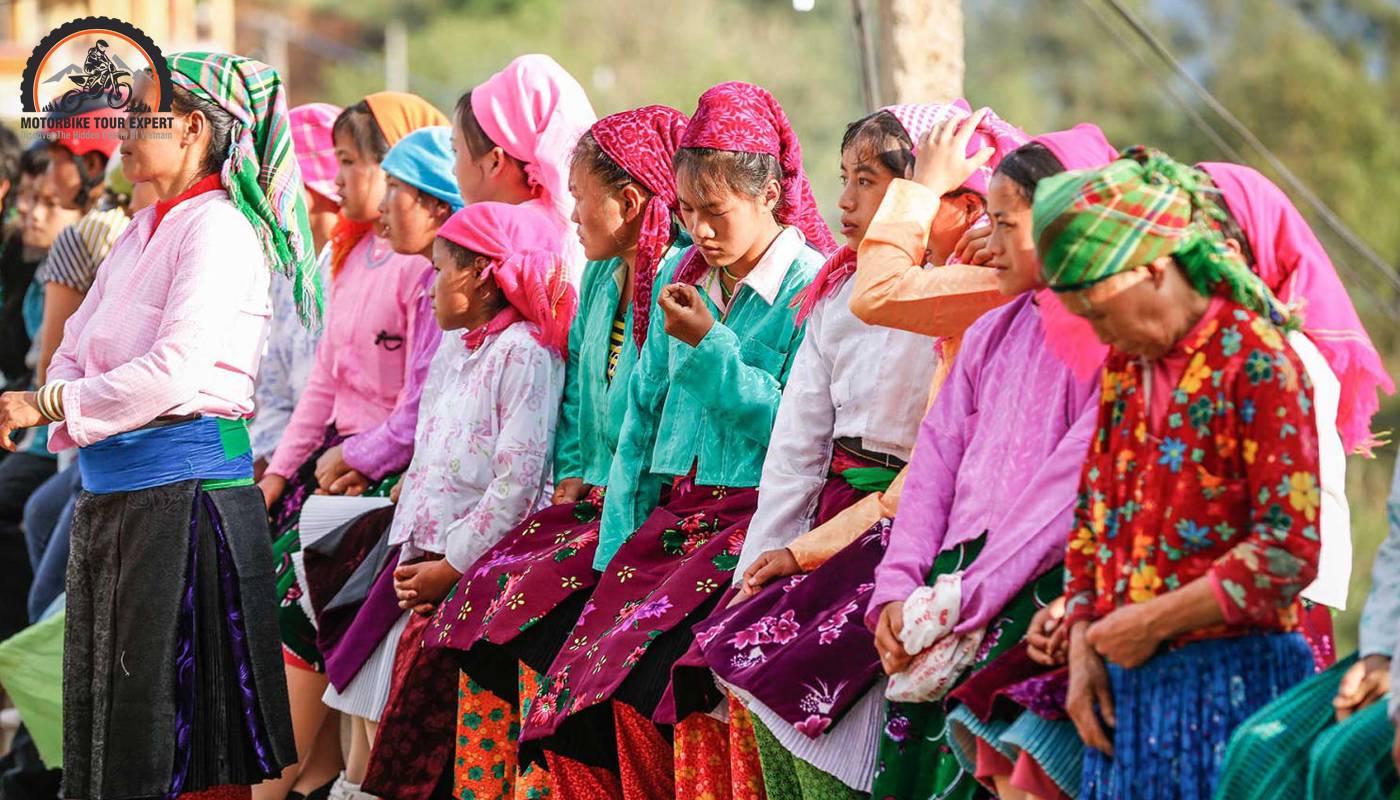
Khau Vai Love Market is one of the famous Ha Giang traditional festivals
Visitors to the Khau Vai love market can not only witness these captivating performances but also participate in a variety of engaging folk games, such as shuttlecock throwing, carrying water with bamboo pipes, and the thrilling love toss. The highlight of the festival is undoubtedly the pound throwing and bird’s nest fighting games, which draw in eager spectators.
Beyond the entertainment, the Khau Vai love market offers a unique opportunity to savor the delectable specialties of Ha Giang, including the renowned “Thắng Cố” and goat hotpot, best enjoyed with the region’s renowned corn wine in the crisp mountain air.
Pu Peo Ethnic Forest God Ceremony
In your captivating Ha Giang motorbike tour, be sure to experience the Pu Peo Ethnic Forest God Ceremony — one of the profound and meaningful Ha Giang traditional festivals that showcases the deep reverence the Pu Peo people hold for the natural world.
The Pu Peo people, who are primarily concentrated in Pho La commune, Dong Van district, observe this ceremony on the 6th day of the 6th lunar month, in addition to their New Year festivities. For the Pu Peo, the forest is not merely a resource, but a cherished friend and protector. The community is deeply committed to preserving the forest, as they rely on its abundant resources for their sustenance and well-being.
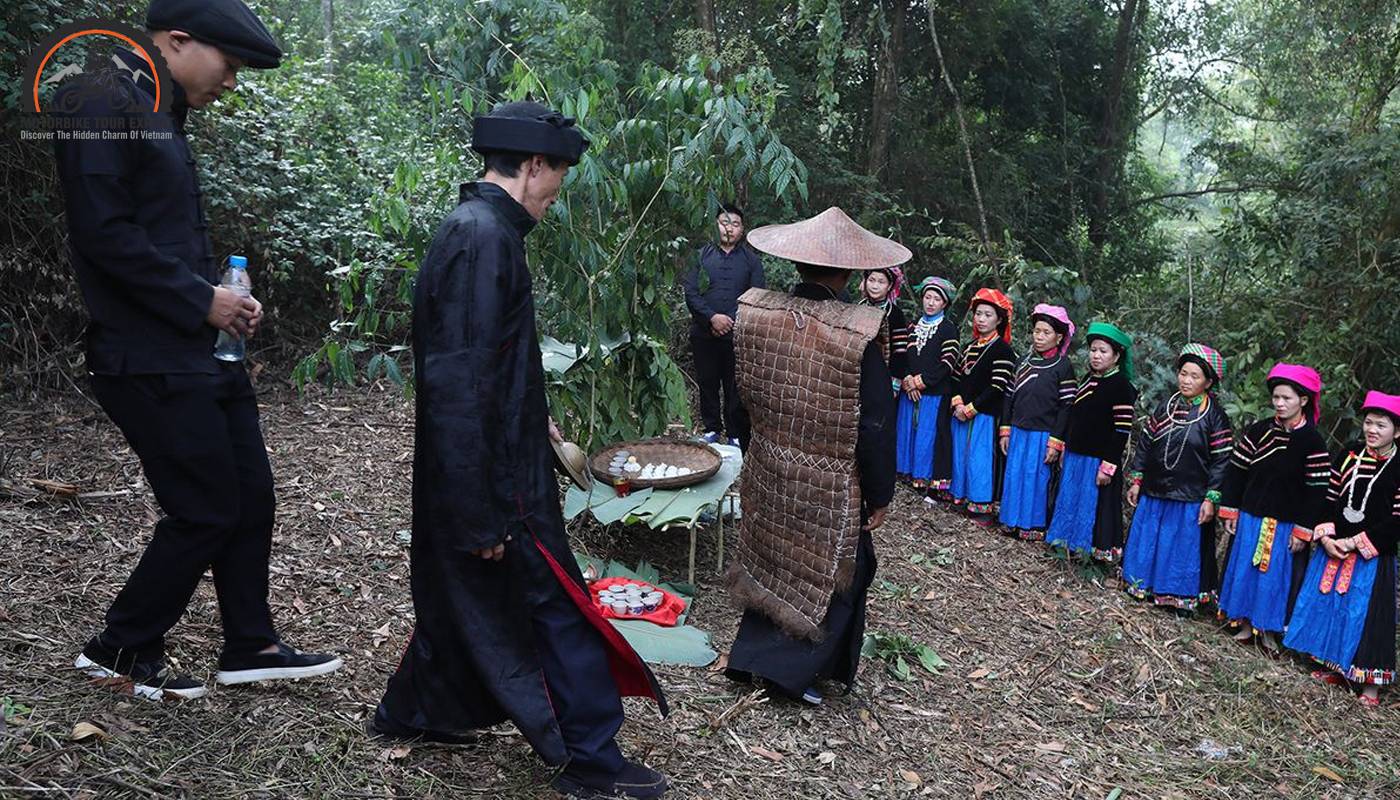
Ceremony to worship the Forest God of Pu Peo people in Ha Giang – Cultural beauty that needs to be passed down
The ceremony takes place in the sacred, forbidden forest at the edge of the village. The shaman, on behalf of the people, pays homage to the Forest God, the God of Heaven, the God of Earth, and the God of Water, by kneeling and bowing in reverence. The offering of chicken and goat meat is a gesture of respect, as the Pu Peo people seek the blessings of these deities for good health, abundant rainfall, and bountiful harvests.
Beyond the spiritual aspects, the Pu Peo Ethnic Forest God Ceremony also features a lively array of traditional sports competitions, such as stick pushing, tug-of-war, bird’s nest fighting, and the playful game of “ao”. Furthermore, the festival showcases the rich cultural heritage of the Pu Peo people through captivating dance and song performances, as well as enchanting repartee singing and love-making rituals.
Cap Sac Festival
Amidst the vibrant tapestry of Ha Giang traditional festivals, the Cap Sac Ceremony, also known as the Linh Tinh Ceremony, stands as a profound and sacred rite of passage for the Dao ethnic community.
The Cap Sac Ceremony is not just a celebratory event but also serves as a profound educational experience, guiding the participants towards upright living and steering them away from wrongdoing. The specific organizing days, regulations, and the number of participants may vary among the different Dao subgroups, such as the Red Dao, Tien Dao, and Ao Dai.
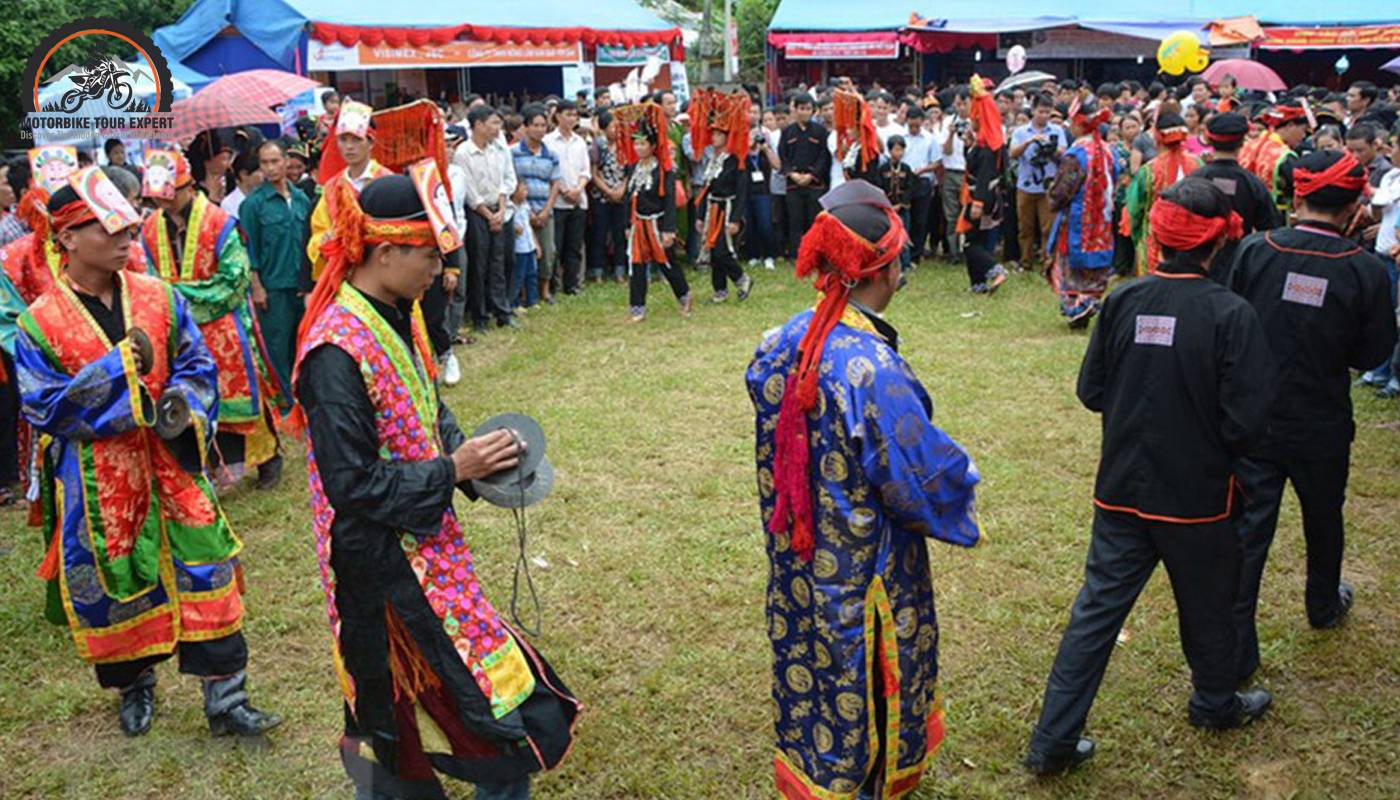
The Red Dao people’s granting ceremony implies concepts of education and philosophy of life
From the Gau Tao to the Cap Sac, The captivating Ha Giang traditional festivals possess the power to captivate and transform the visitor. As one navigates the winding roads and breathtaking landscapes of this enchanting region, the rich cultural tapestry of Ha Giang’s festivals has the potential to enrich the journey and leave an indelible mark on the heart and soul. Immersing oneself in the captivating world of these traditional festivals unlocks the true essence of this remarkable region. Contacting Vietnam Motorbike Tour Expert provides an opportunity to plan an unforgettable Ha Giang motorbike adventure!

















